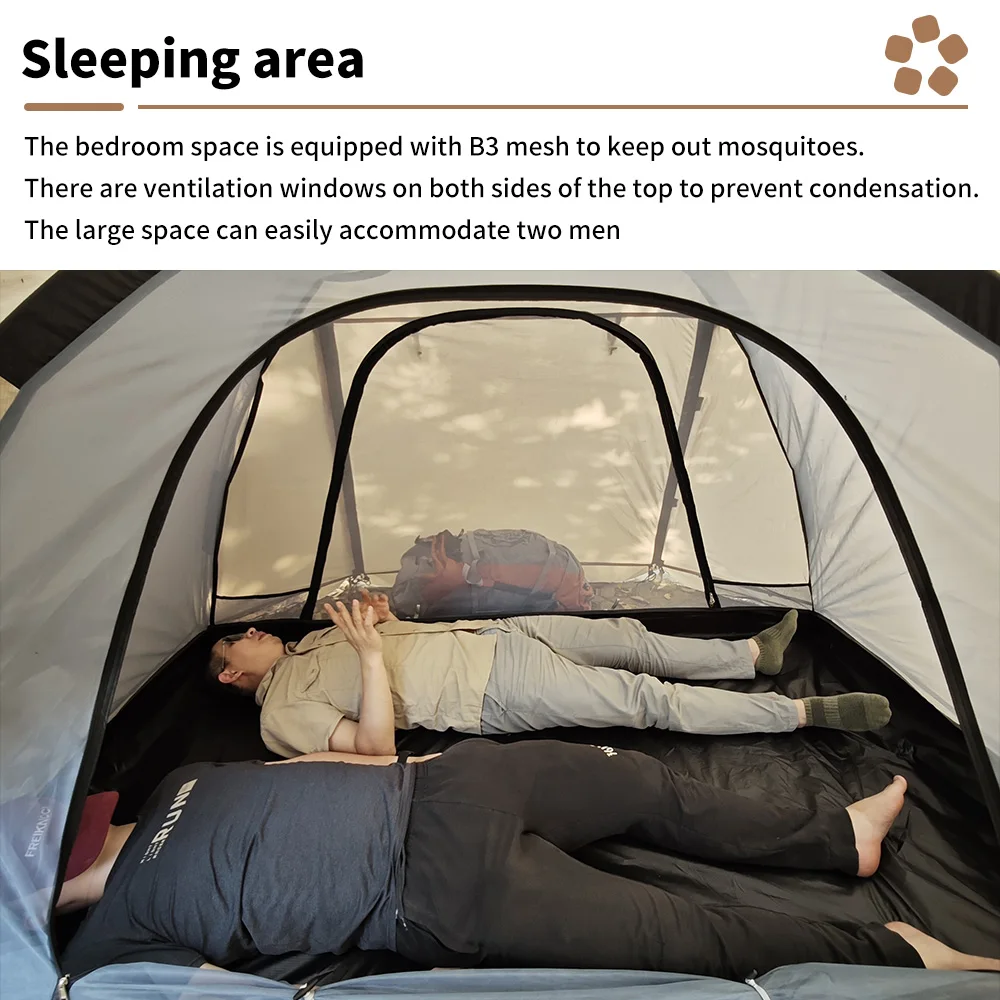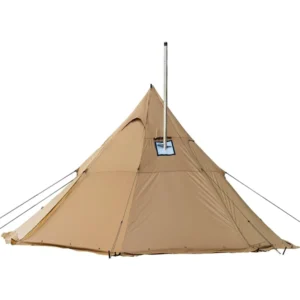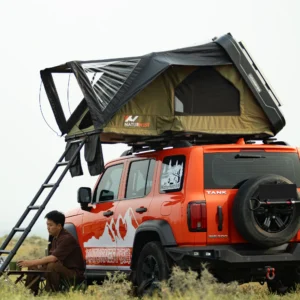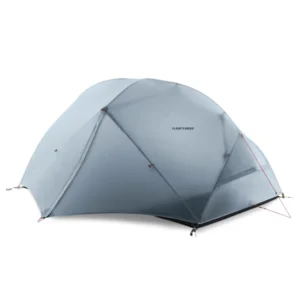Introduction: Conquering the Elements – Why Durability Matters for Four-Season Tents
When venturing into extreme environments, your shelter isn’t just a convenience—it’s your lifeline. Four-season tents represent the pinnacle of outdoor shelter technology, specifically engineered to withstand harsh winter conditions including heavy snow loads, high winds, and freezing temperatures that would flatten standard camping tents.
The durability of these specialized shelters isn’t just a selling point—it’s a critical safety feature. In remote winter environments, a tent failure can quickly escalate from inconvenience to emergency. When you’re miles from help with temperatures well below freezing, your tent becomes your most important survival tool.
What makes a truly durable four-season tent? It’s a combination of:
- Strategic design architecture that sheds snow and stands firm against high winds
- Premium materials with higher denier ratings for tear resistance
- Reinforced stress points and robust frame systems
- Weatherproof coatings that maintain integrity in extreme conditions
Understanding these crucial elements helps you make informed decisions when selecting durable tents for all seasons. The wrong choice could leave you exposed to the elements when you least expect it.
In alpine environments, winds commonly exceed 50 mph, and unexpected snowfalls can deposit hundreds of pounds of weight on your shelter in just hours. The difference between an adequate tent and an exceptional one becomes crystal clear in these moments. Throughout this guide, we’ll explore the technical aspects that distinguish truly reliable four-season tents from their fair-weather counterparts.
Our Top Picks: Most Durable Four-Season Tents for Every Adventure
Selecting the best four-season tents requires rigorous evaluation across multiple criteria. Our recommendations come from extensive field testing in diverse conditions—from wind-swept alpine ridges to heavy snowfall environments—combined with detailed material analysis and structural assessment.
Each tent in our selection balances durability with practical considerations like weight, packability, and livability. We’ve identified options spanning different use cases, from lightweight winter backpacking to hardcore mountaineering expeditions, ensuring you’ll find a shelter suited to your specific adventure needs.
Our evaluation particularly emphasized durability factors including fabric denier ratings, pole diameter and materials, reinforcement placement, and weatherproofing technologies—the elements that truly determine performance when conditions deteriorate.
Best Overall Durable Four-Season Tent: The North Face Mountain Fortress
The North Face Mountain Fortress stands as the benchmark for four-season tent durability, combining robust construction with practical design and exceptional weather resistance.
Key Specifications:
– Floor material: 70D nylon with 3000mm waterproof rating
– Rainfly: 75D ripstop nylon with 2000mm waterproof rating
– Poles: 9.6mm DAC aluminum with integrated hub system
– Weight: 8 lbs 12 oz (4 kg)
– Architecture: 5-pole geodesic dome with multiple crossover points
The Mountain Fortress features a true geodesic structure with five interconnected poles creating multiple crossover points that distribute stress evenly, allowing it to withstand significant snow loads and wind exposure. The tent’s high-denier nylon fabric resists tears and punctures even after years of use, while reinforced stake points prevent common failure areas from degrading over time.
What distinguishes this tent is its thoughtful balance of durability elements with practical usability. Despite its robust construction, setup remains manageable even with gloved hands in windy conditions. The nearly full-coverage rainfly extends close to the ground, eliminating the vulnerability of exposed mesh found in three-season designs.
For those seeking reliable shelter in unpredictable environments, our heavy-duty 4-season tent collection offers excellent options similar to the Mountain Fortress, with variations to suit different space and weight requirements.
Pros:
– Exceptional stability in high winds
– Superior snow-load capacity
– Reinforced stress points prevent long-term wear
– Multiple vestibules for gear storage
– Well-designed ventilation prevents condensation
Cons:
– Heavier than minimalist options
– Premium price point
– Requires experience to achieve optimal pitch
Best Four-Season Tent for Extreme Expeditions: Mountain Hardwear Trango
When the environment becomes truly hostile, the Mountain Hardwear Trango demonstrates why it’s been a staple on serious expeditions for years. This tent represents the pinnacle of durability engineering for the most severe conditions on earth.
Key Specifications:
– Floor material: 70D nylon with 10,000mm waterproof rating
– Rainfly: 70D nylon ripstop with 3000mm waterproof rating
– Poles: 9.5mm DAC Featherlite aluminum
– Weight: 10 lbs 4 oz (4.65 kg)
– Architecture: 5-pole geodesic with welded reinforcement points
The Trango’s expedition-grade construction begins with its pole system—DAC aluminum poles with enlarged diameters provide exceptional strength-to-weight ratio. These feed into reinforced pole sleeves with bartacked stress points, creating a framework that has withstood documented 70+ mph winds in high-altitude environments.
What truly separates this tent is its attention to expedition-specific details. The bathtub floor extends high up the walls to prevent spindrift and ground moisture intrusion. Multiple guy-out points—each reinforced with extra stitching and webbing—allow for bomber anchoring in any terrain. The tent’s materials maintain flexibility even in sub-zero temperatures, preventing cracking or brittleness when pitched in extreme cold.
Explore our mountaineering tent collection for specialized shelters designed for high-altitude and extreme weather conditions.
Pros:
– Unmatched stability in extreme winds
– Exceptional cold-weather performance
– Multiple reinforcement points prevent failure
– Proven reliability on major expeditions
– Generous interior space for long-duration comfort
Cons:
– Heaviest option in our recommendations
– Premium price reflects specialized design
– Overkill for moderate winter conditions
Best Durable Four-Season Tent for Winter Backpacking: Hilleberg Nallo
The Hilleberg Nallo masterfully balances the competing demands of durability and packability, making it our top recommendation for winter backpackers who need reliable protection without excessive weight.
Key Specifications:
– Floor material: 70D nylon with 5000mm waterproof rating
– Rainfly: 40D Kerlon 1200 ripstop nylon with 3000mm waterproof rating
– Poles: 9mm DAC aluminum
– Weight: 5 lbs 8 oz (2.5 kg)
– Architecture: Tunnel design with 3 poles and optimized guy points
The Nallo’s ingenious tunnel design achieves structural integrity with fewer poles than dome configurations, significantly reducing weight without compromising strength. Its Kerlon 1200 outer fabric delivers exceptional tear strength (26 pounds) despite its relatively modest 40D specification, demonstrating how advanced materials and construction techniques can outperform what raw denier ratings might suggest.
Particularly impressive is the tent’s performance in windy conditions when properly pitched—the aerodynamic profile cuts through wind rather than fighting against it. The integrated vestibule provides covered storage space without adding separate poles, further optimizing the weight-to-functionality ratio.
While slightly less robust than expedition-specific options for extended severe weather, the Nallo represents the sweet spot for backpackers who face occasional harsh conditions but prioritize carrying efficiency. Our winter camping tent collection features additional options balancing weight and weather protection.

Pros:
– Exceptional strength-to-weight ratio
– Remarkably small packed size
– Quick setup even in windy conditions
– Excellent ventilation controls condensation
– Proven durability in harsh environments
Cons:
– Tunnel design requires more careful site selection
– Less freestanding than dome designs
– Higher price than entry-level winter tents
Best Value Durable Four-Season Tent: REI Co-op Arete ASL
The REI Co-op Arete ASL demonstrates that durability in winter conditions doesn’t necessarily require spending top dollar, offering thoughtfully designed protection at a more accessible price point.
Key Specifications:
– Floor material: 66D ripstop polyester with 3000mm waterproof rating
– Rainfly: 75D polyester with 1500mm waterproof rating
– Poles: 9mm 7000-series aluminum
– Weight: 6 lbs 2 oz (2.8 kg)
– Architecture: 2-pole dome with third pole for vestibule
The Arete ASL achieves its value proposition through strategic material choices. While it uses slightly less expensive fabric than premium options, it maintains critical durability features where they matter most—reinforced stake points, robust zippers, and a pole structure that effectively sheds moderate snow loads. The polyester construction, while less expensive than nylon, actually offers better UV resistance and minimal stretching when wet.
The tent demonstrates intelligent compromise, focusing durability investments on common failure points while accepting reasonable tradeoffs elsewhere. The 2-pole dome with crossing points provides respectable stability in moderate winds (rated confidently to 30+ mph), while the third pole creates a functional vestibule for gear storage.
Pros:
– Excellent durability-to-price ratio
– Good snow-shedding capability
– Reinforced stress points prevent common failures
– Straightforward setup process
– Reasonable weight for winter backpacking
Cons:
– Less suitable for extended harsh conditions
– Lower hydrostatic head ratings than premium models
– Limited vestibule space
Best Spacious & Durable Four-Season Tent: Black Diamond Eldorado
The Black Diamond Eldorado proves that durability doesn’t have to mean cramped quarters, delivering a spacious interior while maintaining expedition-grade protection against the elements.
Key Specifications:
– Material: ToddTex single-wall fabric with proprietary breathable waterproofing
– Poles: 8mm DAC Featherlite aluminum
– Weight: 7 lbs 5 oz (3.3 kg)
– Interior dimensions: 34 sq ft floor area, 43-inch peak height
– Architecture: Modified dome with dual crossing poles
Unlike most four-season options, the Eldorado employs a single-wall design using ToddTex fabric—a breathable waterproof material that eliminates the need for separate fly and canopy. This innovation maintains protective integrity while creating more usable interior space and simpler setup.
The tent’s generous dimensions provide not just sleeping space but genuine livability for extended trips. With 34 square feet of floor area and a 43-inch peak height, occupants can sit upright comfortably and spread out gear inside when conditions prevent outside activities. This spaciousness proves invaluable during storm days when you’re tent-bound for hours or days.
Despite its interior volume, the tent maintains impressive structural strength through a modified dome architecture with dual crossing poles that insert into reinforced sleeve pockets. The design effectively sheds snow while resisting deformation in strong winds.
Our 4-season winter 2-person tents collection features additional options balancing interior space with winter-ready construction.
Pros:
– Exceptional interior volume for winter shelter
– Single-wall design simplifies setup
– Breathable waterproof material reduces condensation
– Multiple interior pockets maximize organization
– Resists high winds despite larger profile
Cons:
– Single-wall design can show more condensation in certain conditions
– Higher weight than minimalist options
– Requires more careful ventilation management
Understanding Four-Season Tent Design Philosophy
Four-season tents represent a fundamentally different engineering approach than their three-season counterparts. While three-season tents prioritize ventilation, weight savings, and fair-weather comfort, four-season designs focus on structural integrity above all else.
The core difference begins with the frame architecture. Three-season tents typically utilize minimal pole structures with wider spans between supports, whereas four-season models employ additional poles, more crossing points, and steeper wall angles. This creates geometric strength that prevents collapse under snow loads and maintains stability against powerful winds.
Rainfly coverage represents another key philosophical difference. Three-season tents often use partial rainflies to enhance ventilation, while four-season tent features include full-coverage flies that extend to the ground, eliminating vulnerable gaps where driving snow can penetrate. This comprehensive protection creates a complete weather seal at the expense of some ventilation.
The balance between breathability and weather protection illustrates the distinct design approaches. Three-season tents maximize airflow with extensive mesh panels, while four-season models use limited, strategic ventilation points that can be completely sealed when necessary. This creates microclimates inside the tent that retain warmth in winter conditions while providing just enough air exchange to manage condensation.
These fundamental design differences explain why attempting to use a three-season tent in winter often ends poorly—the entire engineering philosophy addresses different environmental challenges.
Materials Science: Fabric Types & Denier Ratings
The fabric selection in four-season tents represents a critical durability factor, with each material offering distinct advantages and limitations for extreme conditions.
Nylon vs. Polyester: The Primary Contenders
Nylon dominates premium four-season tents due to its superior strength-to-weight ratio. It provides approximately 25% greater tear strength than polyester of equivalent weight, allowing manufacturers to achieve necessary durability with less material weight. However, nylon absorbs moisture and stretches when wet, requiring proper tensioning during setup and potentially re-adjustment after precipitation.
Polyester, while slightly heavier for equivalent strength, offers better UV resistance and minimal stretching when wet. This dimensional stability makes it particularly valuable for extended trips where constant re-tensioning would be impractical.
Understanding Denier Ratings
Denier (D) measures fabric thread thickness—higher numbers indicate thicker threads and generally stronger materials. Typical specifications for four-season tents include:
| Tent Component | Common Denier Range | Purpose |
|---|---|---|
| Rainfly | 40D-75D | Weather protection, snow/wind resistance |
| Floor | 50D-70D | Puncture and abrasion resistance |
| Canopy Body | 30D-40D | Interior durability with some weight savings |
However, denier alone doesn’t tell the complete story. The all-season tent materials used in quality shelters incorporate additional strengthening techniques like ripstop construction—a reinforcing grid pattern that prevents tears from spreading. This explains why some lower-denier fabrics outperform higher-denier alternatives in real-world durability.
Advanced Materials
Dyneema Composite Fabrics (formerly Cuben Fiber) represent the cutting edge in tent materials, offering extraordinary strength at minimal weight. These non-woven composites provide exceptional waterproofing and tear resistance but come with premium prices and limited availability in mainstream tent models.
Waterproof Coatings & Hydrostatic Head
The invisible barrier between you and the elements relies on sophisticated waterproofing technologies that balance weather protection with material longevity.
Polyurethane (PU) coatings represent the most common waterproofing approach, applying synthetic rubber compounds to the fabric’s interior surface. These create an effective moisture barrier at moderate cost but can degrade over time, particularly when stored damp or exposed to high humidity.
Silicone coatings, often referred to as “silnylon” when applied to nylon, offer superior durability and longer-term performance. Particularly advanced are dual-sided silicone applications, which provide exceptional tear strength enhancement along with waterproofing. The downside comes with higher cost and sometimes challenges with seam sealing.
Hydrostatic head ratings quantify waterproof performance, measuring how tall a column of water (in millimeters) a fabric can support before leakage occurs. For four-season tents, typical specifications include:
- Rainfly: 1500-3000mm (minimum 1500mm for snow and heavy rain)
- Floor: 3000-10,000mm (higher ratings for ground contact surfaces)
These ratings directly impact weather resistance and durability in camping tents, with higher numbers indicating better performance in sustained wet conditions. However, extremely high ratings can sometimes indicate heavier, stiffer fabrics, requiring balanced design decisions.
Seam sealing represents the final critical element in waterproofing. Even perfect fabric becomes vulnerable at stitch points. Modern techniques include:
- Taped seams: Waterproof tape applied over stitching
- Welded seams: Heat-bonded connections without needle penetration
- Liquid seam sealers: Manually applied waterproof compounds
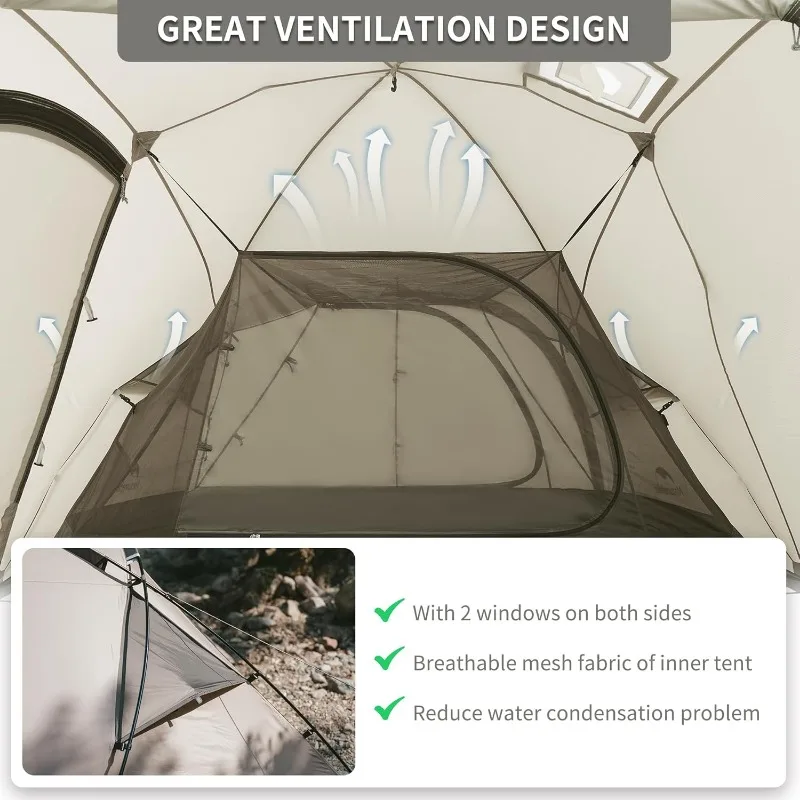
Pole System: The Skeleton of Strength
The frame system constitutes the critical foundation of four-season tent durability, determining how the shelter performs under stress from wind, snow loads, and even user handling.
Pole Materials: Strength Behind the Structure
Aluminum alloys dominate winter tent pole construction, with most premium models utilizing DAC (Dongah Aluminum Corporation) poles in 7000-series alloys. These specialized aluminum formulations balance strength, weight, flexibility, and resistance to permanent deformation. Key specifications include:
- Diameter: 8-11mm (larger diameters for expedition tents)
- Wall thickness: Standard vs. Featherlite (thinner walls reduce weight)
- Connection system: Internal shock cord vs. external connection hubs
Carbon fiber poles offer weight savings but with significant tradeoffs—they’re more brittle in extreme cold and catastrophically fail rather than bend when overloaded. This makes them rare in true four-season designs except as supplementary supports.
Architectural Designs
The pole architecture fundamentally determines structural integrity, with several dominant approaches:
- Geodesic/Semi-geodesic: Multiple poles create triangular patterns for maximum strength-to-weight ratio; ideal for extreme conditions
- Dome: Simplified crossing pole pattern sacrifices some stability for easier setup
- Tunnel: Non-freestanding design uses tension for stability; very storm-worthy when properly anchored
- Hybrid: Combines elements of multiple designs for balanced performance
The number of pole crossover points directly correlates with stability—more intersections create smaller fabric panels with better wind resistance and snow-load capacity. This explains why essential features for snow camping tents include more complex pole structures than three-season equivalents.
Floor & Groundsheet Construction for Longevity
The tent floor faces unique durability challenges—constant abrasion, puncture threats, and ground moisture make this component particularly vulnerable to damage and failure.
Four-season tent floors typically feature thicker materials than walls, with denier ratings ranging from 50D to 70D for most quality models. These heavier fabrics resist punctures from rocks, ice, and equipment while maintaining flexibility in cold conditions.
The “bathtub” floor design represents a critical winter tent feature, creating waterproof walls that extend 3-6 inches up from the ground before transitioning to the main body material. This elevation prevents water and snow from seeping in at the perimeter—particularly important when camping on snow that may melt beneath the tent or during unexpected rainfall on frozen ground.
Groundsheets (footprints) provide additional protection by creating a sacrificial barrier between the tent floor and abrasive surfaces. While adding weight, these accessories significantly extend floor life by absorbing wear that would otherwise damage the tent itself. Most manufacturers offer custom-fitted footprints, though universal options work with careful sizing (keeping them slightly smaller than the tent floor to prevent water collection).
Material selection for floors balances competing priorities:
- Nylon offers superior strength but absorbs some moisture
- Polyester provides better water resistance but slightly lower tear strength
- TPU and PVC laminations enhance waterproofing but add weight and stiffness
Hardware & Reinforcements: Small Details, Big Impact
The difference between adequate and exceptional four-season tents often comes down to seemingly minor hardware components and reinforcement techniques that prevent failure in challenging conditions.
Zipper Systems
Zippers represent common failure points in extreme environments. Quality four-season tents utilize:
- YKK zippers (typically #8 or #10 size for main doors)
- Zipper garages that shield closure points from moisture
- Zipper lubricant treatments for cold-weather functionality
- Reverse coil designs that place the coil inside for weather protection
Critical Reinforcements
Strategic reinforcement of high-stress areas prevents cascading failures:
- Bar-tacking (dense stitching) at guy-out points can withstand 100+ pounds of force
- Webbing reinforcements distribute load across wider fabric areas
- Double-stitched seams prevent progressive failure
- Cord lock adjusters that function with gloved hands
- Reflective guy lines for nighttime visibility and added stability
The stake-out system significantly impacts wind and snow load capacity in durable tents. Premium models include:
- Multiple guy-out points (typically 8-12) for distributed anchoring
- Reinforced stake loops with cord adjusters
- Snow/sand pockets for securing the tent when traditional stakes won’t work
- Adjustable tensioners for maintaining proper pitch as fabrics stretch
These seemingly minor components can mean the difference between a tent that survives years of expedition use and one that fails during its first significant storm.
Ventilation & Condensation Management
Effective moisture management represents a unique challenge for four-season tents—they must simultaneously block external precipitation while preventing internal condensation from accumulating on surfaces and potentially soaking gear.
In cold environments, the temperature differential between warm, humid air inside the tent (from respiration and body heat) and freezing conditions outside creates perfect conditions for condensation formation. Without proper ventilation, this moisture accumulates on interior surfaces, potentially soaking sleeping bags and gear.
Quality four-season tents employ strategic ventilation systems:
- Adjustable roof vents positioned to create chimney airflow
- Protected side vents that remain functional during snowfall
- Vestibule vents that minimize cooking condensation
- Dual-zipper doors allowing partial opening for air exchange
Most effective designs include multiple adjustable vents positioned to create directional airflow—drawing cooler air from low entry points and exhausting warm, moist air through higher exits. This creates natural convection that manages moisture without excessive heat loss.
Proper tent management also significantly impacts condensation control:
- Brushing snow off clothing before entering
- Minimizing cooking inside the tent
- Proper site selection to avoid naturally humid areas
- Shaking out accumulated frost each morning
While perfect condensation prevention remains impossible in extreme conditions, well-designed ventilation systems minimize its impact on comfort and gear longevity.
UV Resistance & Environmental Degradation
Ultraviolet radiation represents an often-overlooked threat to tent durability, progressively weakening synthetic fabrics and degrading waterproof coatings even during limited exposure.
Different tent materials exhibit varying UV resistance:
- Polyester naturally provides better UV protection than nylon
- Silicone coatings offer superior UV resistance compared to polyurethane
- Colors impact UV protection (lighter colors reflect more radiation but show dirt)
- Specialized UV inhibitor treatments extend fabric life significantly
The effects of UV exposure manifest progressively:
- Reduced fabric strength (up to 40% loss after extended exposure)
- Diminished waterproof coating effectiveness
- Fabric brittleness and cracking in extreme cases
- Color fading (cosmetic but indicates ongoing damage)
Geographic factors significantly impact UV exposure, with high altitude and low latitude locations (mountains, deserts, tropical regions) presenting accelerated degradation risks. A tent used primarily at high elevation can experience years’ worth of UV damage during a single extended expedition.
Prevention strategies include:
- Setting up in shaded areas when possible
- Using UV-blocking groundsheets as overhead protection during extended base camping
- Applying aftermarket UV protectant sprays to extend fabric life
- Minimizing unnecessary daytime deployment
Weight vs. Durability vs. Cost: Finding Your Balance
The fundamental challenge in selecting a four-season tent involves balancing three competing factors:
- Durability: The tent’s ability to withstand harsh conditions
- Weight: How much burden it adds to your pack
- Cost: The financial investment required
These factors exist in constant tension—improving one typically requires compromising another. Understanding your specific needs helps determine where compromises make sense.
Typical Weight-Durability-Cost Relationships:
| Category | Weight Range | Relative Durability | Price Range | Ideal Use Case |
|---|---|---|---|---|
| Ultralight | 3-5 lbs (1.4-2.3 kg) | Moderate | High | Short winter trips, mild conditions |
| Balanced | 5-8 lbs (2.3-3.6 kg) | Good | Moderate-High | Most winter backpacking |
| Expedition | 8-12 lbs (3.6-5.5 kg) | Excellent | Very High | Extreme environments, base camping |
Your optimal balance depends on several factors:
- Trip duration (longer trips may justify more weight for durability)
- Environmental severity (harsher conditions require greater durability)
- Travel method (backpacking vs. base camping vs. supported expedition)
- Personal risk tolerance (consequences of potential failure)
Finding this balance means honestly assessing your requirements rather than automatically selecting the most expensive or lightest option. Someone planning occasional winter camping in established areas has very different needs than a mountaineer attempting a high-altitude expedition. For primary snow camping use, selecting from durable tents for extreme outdoor adventures makes sense, while occasional winter users might prioritize versatility.
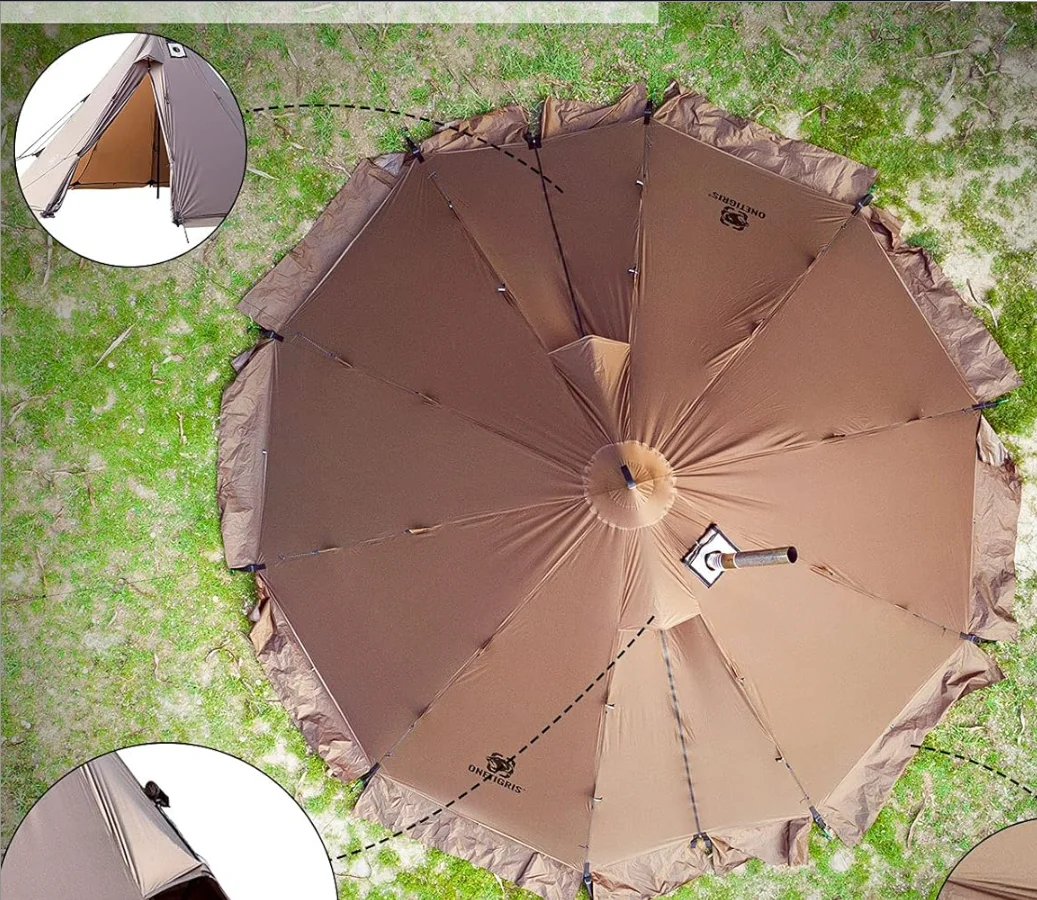
Heavy Duty 4 Season Tent, Mountaineering Tent, Winter Camping Tent
$870.40 Select options This product has multiple variants. The options may be chosen on the product pageUltralight Backpacking Tent, Ultralight Dome Tent, Winter Camping Tent
Price range: $369.63 through $370.07 Select options This product has multiple variants. The options may be chosen on the product pageHeavy Duty 4 Season Tent, Ultralight Freestanding Tent, Winter Camping Tent
$3,722.66 Select options This product has multiple variants. The options may be chosen on the product pageHeavy Duty 4 Season Tent, Winter Camping Tent
$638.69 Select options This product has multiple variants. The options may be chosen on the product pageHeavy Duty 4 Season Tent, Winter Camping Tent
$5,109.59 Select options This product has multiple variants. The options may be chosen on the product pageBackpacking Tent with Vestibule, Heavy Duty 4 Season Tent, Trekking Pole Backpacking Tent, Winter Camping Tent
Price range: $257.52 through $537.51 Select options This product has multiple variants. The options may be chosen on the product page
Maximizing Tent Lifespan: Care and Maintenance
Proper maintenance dramatically extends a four-season tent’s functional lifespan, protecting your investment while ensuring reliability when you need it most.
Cleaning Protocol
- Field cleaning: Shake out debris daily during trips
- Post-trip cleaning:
– Brush away dirt before packing
– Set up at home and sweep interior
– Spot-clean dirty areas with mild soap and cold water
– Never machine wash or use harsh detergents
– Clean zippers with soft brush and remove debris
Drying and Storage
- Complete drying: Always fully dry before storage (12-24 hours minimum)
- Proper storage technique:
– Loosely rolled or stuffed (never tightly compressed)
– Store in dry, cool location
– Use storage sack rather than stuff sack
– Avoid direct sunlight
– Keep away from heat sources and chemicals
Field Repairs
Essential repair kit components include:
– Seam sealer
– Adhesive repair patches
– Spare guy line
– Pole repair sleeve
– Multi-tool with needle and thread
For professional repairs, document damage with photos before sending to the manufacturer or specialized repair services. Address issues promptly—small problems often progress to major failures when neglected.
Common Mistakes That Compromise Tent Durability
Even the most durable four-season tent becomes vulnerable when improperly used or maintained. Avoiding these common mistakes significantly extends your shelter’s lifespan:
Setup Errors
- Uneven tensioning: Creates stress points and asymmetrical loading
- Over-tightening guy lines: Stresses fabric and seams beyond design limits
- Inadequate staking: Allows excessive movement that weakens materials over time
- Improper site selection: Abrasive surfaces, falling debris hazards, and water collection areas accelerate wear
Storage Mistakes
- Storing wet or damp: Creates mildew that degrades fabric and coatings within days
- Long-term compression: Damages coatings and creates permanent creases
- Exposure to heat: Degrades waterproof treatments and weakens synthetic fabrics
- Rodent exposure: Results in catastrophic damage from nesting materials
Handling Errors
- Forced zippers: Damages teeth and sliders that are difficult to repair
- Sharp objects inside: Creates punctures and tears, particularly in floor materials
- Cooking inside: Damages fabrics with heat, grease, and condensation
- Boot entry: Damages floor materials with abrasion and punctures
Understanding how to properly set up tents in winter conditions significantly reduces wear while ensuring optimal performance when you need it most.
Is a Four-Season Tent Worth the Higher Cost?
The considerable price premium for quality four-season tents raises legitimate questions about value. While three-season tents may cost $200-400, true four-season models typically range from $500 to well over $1,000. Is this investment justified?
For those who genuinely need winter weather protection, the value proposition becomes clear when considering:
Risk Assessment: Equipment failure in remote winter environments carries significantly higher consequences than in mild conditions. The cost difference pales compared to the potential emergency scenarios created by inadequate shelter.
Longevity Calculation: Quality four-season tents typically last 7-10+ years with proper care, compared to 3-5 years for many three-season models under similar use patterns. When amortized over their useful life, the annual cost difference diminishes substantially.
Versatility Consideration: Many four-season tents can be configured for three-season use (removing rainfly, opening vents, etc.), effectively providing two tents in one for users who camp year-round.
Rental Alternative: For occasional winter use, renting specialized equipment may offer better value than purchasing, though availability can be limited for high-quality four-season models.
The most reasonable approach considers your specific needs—frequency of winter camping, environmental severity, and risk factors all influence whether the investment makes sense for your situation.
Can You Use Durable Four-Season Tents Year-Round?
Many outdoor enthusiasts wonder if they can use a single tent for all conditions, eliminating the need for multiple shelters. While four-season tents excel in winter, their performance in warmer conditions varies significantly based on design.
During summer camping, four-season tents present several challenges:
- Limited ventilation can create uncomfortable interior temperatures
- Heavier materials add unnecessary pack weight
- Full-coverage rainflies reduce air circulation
- Smaller mesh panels limit bug protection options
However, certain design features mitigate these issues:
- Convertible rainfly configurations that allow partial coverage
- Multiple ventilation points with mesh backing
- Modular component systems allowing seasonal adaptation
Tents specifically designed for multi-season use in variable climates often incorporate these adaptable features, though they may sacrifice some performance at the extremes of either season.
For occasional summer use, managing a four-season tent’s warmth involves:
- Selecting shaded campsites
- Maximizing ventilation configuration
- Using the rainfly in “porch mode” for shade while maintaining airflow
- Setting up during cooler evening hours
How Much Does Denier Rating Actually Matter?
Denier ratings frequently feature prominently in tent specifications, but their relationship with actual durability proves more complex than simple numbers suggest.
While higher denier generally indicates stronger material, many other factors influence real-world performance:
- Fabric construction: Ripstop patterns can make lower-denier fabrics outperform higher-denier plain weaves
- Material quality: The base polymer quality significantly impacts strength (premium 30D may outperform budget 50D)
- Coating technology: Silicone impregnation dramatically increases tear strength compared to surface coatings
- Weave technique: Tighter weaves with more threads per inch increase strength independent of denier
For context, typical denier applications include:
- Ultralight backpacking tents: 10D-30D
- Three-season tents: 20D-40D
- Four-season tents: 30D-70D
- Expedition tents: 50D-70D+
The most reliable approach considers denier alongside other specifications and manufacturer reputation. A lower-denier fabric from a premium manufacturer often outperforms higher-denier material from budget brands due to superior materials and construction techniques.
Are Heavier Tents Always More Durable?
The assumption that heavier tents automatically offer greater durability oversimplifies a complex relationship. While weight and durability often correlate, many factors influence this relationship:
When Weight Indicates Durability:
– Higher fabric denier (thicker materials)
– Additional reinforcement panels
– Larger diameter poles
– More extensive pole structures
– Robust hardware components
When Weight Doesn’t Equal Durability:
– Inefficient design requiring more materials for equivalent strength
– Lower-quality materials that require more volume for equivalent performance
– Outdated construction techniques requiring additional components
– Overbuilt features that add bulk without meaningful durability benefits
Advanced materials and engineering have increasingly challenged the direct weight-durability relationship. Modern examples include:
- Dyneema composite fabrics offering extraordinary strength at minimal weight
- DAC Featherlite NSL poles providing strength comparable to heavier options
- Computer-optimized geometries that maximize structural integrity with fewer materials
When evaluating tents, focus on the purpose behind the weight rather than weight alone. Quality manufacturers provide specific details about materials and construction that reveal whether weight serves structural purposes or results from inefficient design.
What’s the Expected Lifespan of a Quality Four-Season Tent?
With proper care and maintenance, quality four-season tents typically last 7-10+ years of regular use, though this varies significantly based on multiple factors:
Usage Patterns:
– Frequency of deployment (days per year)
– Environmental severity (UV exposure, precipitation, wind)
– Storage conditions between trips
– Setup and handling practices
Typical Lifespan Indicators:
– Coating degradation after 100-200 days of use
– Pole fatigue after 150-300 setup cycles
– Zipper failure after 500-1000 cycles
– Fabric degradation highly variable based on UV exposure
Signs that replacement might be necessary include:
– Significant waterproofing failure despite reapplication attempts
– Multiple repairs to the same component
– Delamination of coatings that cannot be restored
– Pole sections that repeatedly fail or crack
– Zipper failure that cannot be professionally repaired
Premium expedition tents from established manufacturers often outperform these averages, with some models reliably functioning for 15+ years when properly maintained. This exceptional longevity helps justify their higher initial investment for frequent winter campers.

